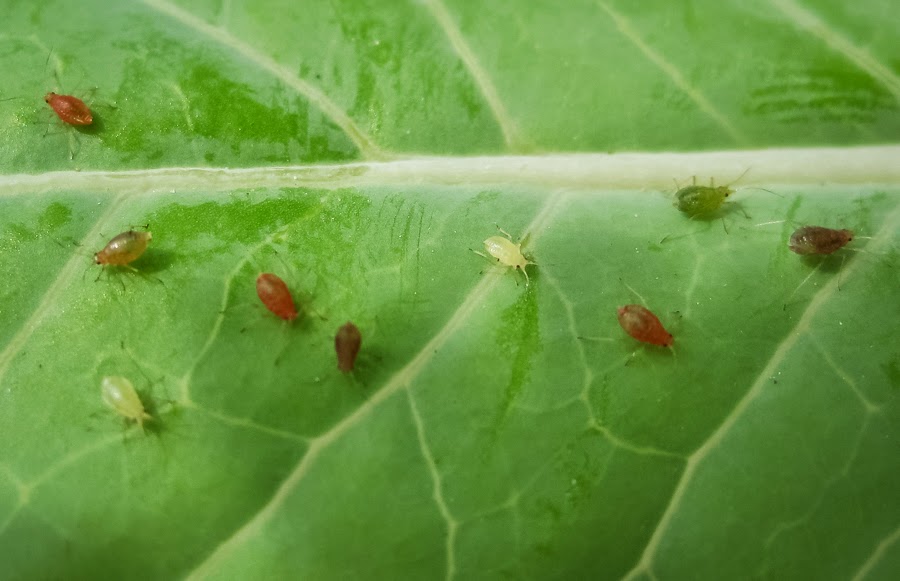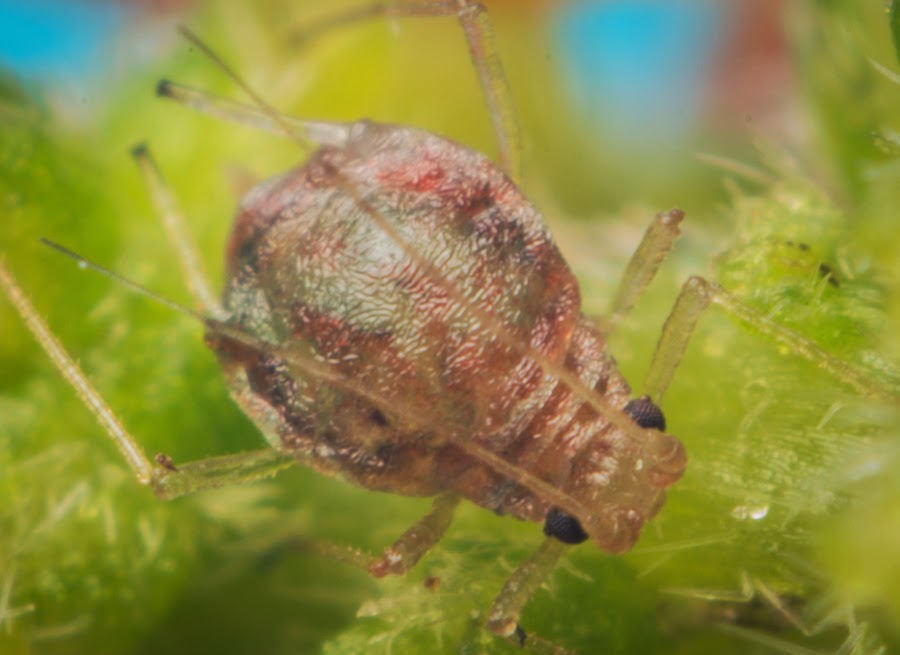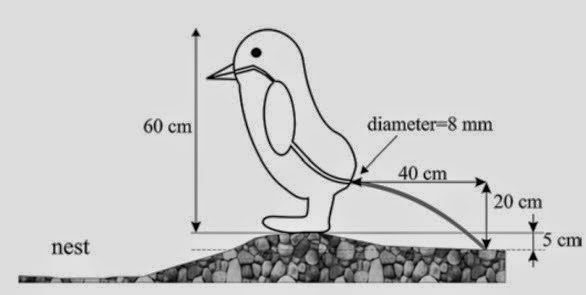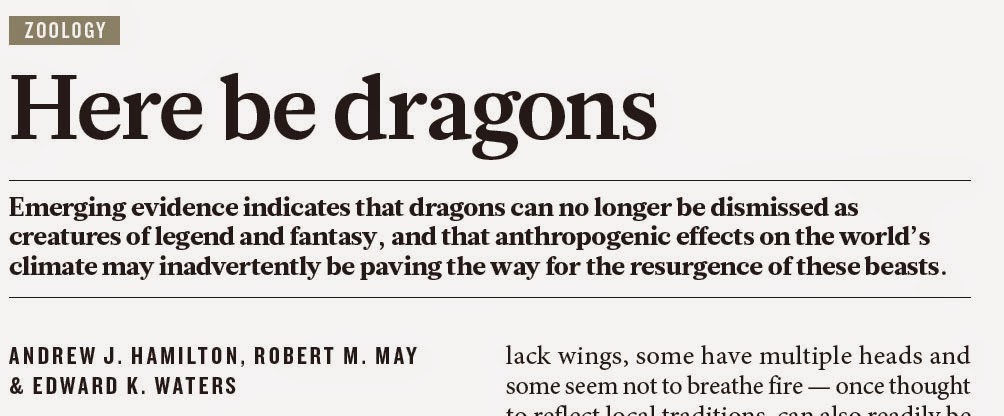 |
| Genetically based color variation in four green peach aphid clones |
Bringing hundreds of paper bags stuffed with aphid-infested plants inside our lab was a very bad idea. Thus began the aphid infestation. All the lab benches, pipettes, centrifuges, computers, everything, were crawling with aphids seeking a new host. Winged aphids swarmed around the lights and windows, and all the molecular-based work my lab mates were doing came to a halt.
 |
| Green peach aphid (Myzus persicae) |
This was the aftermath of a field experiment I (well, actually Marc Johnson and I) conducted, testing the relative ecological importance of herbivore genetic variation and contemporary evolution on plants. In most systems we still don’t know much about the ecological importance of ongoing evolutionary processes. My goal was to directly compare ecological impacts of genetic variation and contemporary evolution to the presence/absence and abundance of a species, two ecological factors we clearly expect to be important.
I studied interactions between green peach aphids (Myzus persicae) and two host plant
species (Brassica napus and Solanum nigrum). Aphids are insect
herbivores that stab their pointy mouthparts into plants to feed on phloem. In large numbers they
can be devastating to plants, and rapidly growing to
large numbers is their specialty. During growing season most aphids reproduce
asexually, giving live birth to dozens of adorable little menaces that can grow
to give birth themselves in as little as four days. You can watch exponential
growth in action over the course of several weeks.
 |
| Momma aphid and her kids |
This natural history makes aphids a great system in which to study the ecological effects of genetic variation. I collected populations of green peach aphids from tobacco fields all across eastern North Carolina and established colonies starting from just one aphid. Because they reproduce clonally each colony contains no genetic variation. For my experiments I choose four aphid clones that represented the full range of population growth rate on plants in the lab. These four clones could be distinguished using molecular markers, a fact that will become important below.
 |
| Colonies of 30 different aphid clones collected in North Carolina |
To test the ecological effects of aphid genetic variation on plants I started populations of each clone on caged plants in the field. I also had no-aphid controls. Then the aphid counting began: kneeling in the field, flipping over every leaf, and clicking away (with a tally counter) for several days straight. Some of the plants had up to 3000 aphids after only 11 days. Once I had estimates of population size I harvested the plants and dried and weighed them – these were the plants that I foolishly brought into the lab.
 |
| Marc Johnson and I glad to be done transferring hundreds of plants into the field |
I found, not surprisingly, that plants with thousands of aphids had greatly reduced biomass. And while aphid abundance was the most important predictor of plant biomass, aphid genotype and aphid presence/absence had similar effects (i.e. they explained similar amounts of variation). This suggests that which genotype of aphid lands on a plant may be of similar ecological importance to whether the plant does or does not have aphids on it at all.
 |
| Field of ghosts experiment. Each plant was caged in polyester bags to prevent movement of aphids between plants. |
Aphids’ asexual reproduction and rapid population growth rates also make it possible to track evolutionary change over short timescales (a few weeks). To do this I started genetically diverse aphid populations with equal numbers of all four of my genotypes. This provided standing genetic variation allowing populations to evolve as they grew. At the end of the experiment I collected a random subsample of aphids from each plant, brought them back to the lab, and identified the genotype of each aphid using microsatellite molecular markers. With this I inferred genotype frequencies on each plant, and by comparing a population’s starting genotype frequency with the final genotype frequency I quantified change in genotype frequency over time – AKA evolution.
I tested whether the host plant influenced the evolutionary rate or
trajectory, and whether evolution feeds back to influence the host plant’s growth. I found
that aphid populations did evolve over approximately 5 generations, but at the
same rate and direction on both host plants. Basically, faster-growing clones increased in genotype frequency whereas slower-growing genotypes decreased.
 |
| Aphids collected from the field and ready for genotyping |
I also found some evidence for an ecological impact of contemporary evolution on the plants. On one of the host plants, faster-evolving populations had a larger negative impact on the plants. The magnitude of this effect was comparable to the impacts of aphid presence/absence and abundance that I mentioned earlier.
In the world of plant-herbivore interactions there are quite
a few studies showing how plant genetic variation influences herbivores, but
there are very few studies testing the impacts of herbivore genetic variation on plants.
So I’m pretty excited to provide a clear example showing that herbivore genetic
variation matters too.
More generally, we know very little about the ecological
importance of ongoing evolutionary change, in no small part because it is
difficult to study in the field. But, similar to bringing thousands of live insects into a
clean lab environment, assuming contemporary evolution is not important is
probably not a good idea.
 |
| My car full of aphid infested plant collections |
Reference: Turley NE, Johnson MTJ. 2015. Ecological effects of aphid abundance, genotypic variation, and contemporary evolution on plants. Oecologia. Link to the paper here.
All photos © Nash Turley, used with permission.



















